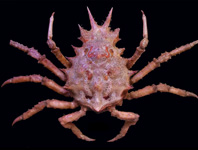Abstract
A new bee species of the genus Dasypoda Latreille (Hymenoptera, Apoidea, Melittidae), D. morawitzi Radchenko sp. nov., is described. This species is closely related to, and easily confusable with, D. hirtipes (Fabricius), and its specimens have been previously attributed to the latter species. A comparative morphological analysis of D. morawitzi with other species of the D. hirtipes group is provided. The distribution and trophic links of this new species are discussed.
References
Ascher, J.S. & Pickering, J. (2014) Discover Life bee species guide and world checklist (Hymenoptera: Apoidea: Anthophila). Avaliable from: http://www.discoverlife.org/mp/20q?guide=Apoidea_species. (accessed 10 May 2016)
Baker, D.B. (2002) A provisional annotated list of the nominal taxa assigned to the genus Dasypoda Latreille, 1802, with the description of an additional species (Hymenoptera, Apoidea, Melittidae). Deutsche entomologische Zeitschrift, 49, 89–103.
http://dx.doi.org/10.1002/mmnd.20020490107Blagoveshenskaya, N.N. (1963) Giant colony of the single bees Dasypoda plumipes Panz. Entomologicheskoe Obozrenie, 42, 115–117.
Celary, W. (2002) The ground-nesting solitary bee, Dasypoda thoracica Baer, 1853 (Hymenoptera: Apoidea: Melittidae) and its life history. Folia biologica (Kraków), 50 (3–4), 191–198.
Celary, W. (2005) Melittidae of Poland (Hymenoptera: Apoidea: Anthophila) their Biodiversity and Biology. Wydawnictwa Instytutu Systematyki i Ewolucji Zwierząt PAN. Krakow: ISEZ PAS Press; 177 pp.
Dalla Torre, C.G. de. (1896) Catalogus hymenopterorum hucusque descriptorum systematicus et synonymicus. Vol. X. Apidae (Anthophila). VIII + 643 pp.; Lipsiae: (Engelmann).
Lind, H. (1968) Nest, provisioning, cycle and daily routine of behavior in Dasypoda plumipes. Entomologiske Meddelelser, 36 (4), 343–372.
Loublier, Y. & Pouvreau, A. (1995) Observations on the biology of Dasypoda hirtipes F., Apoidea (Melittidae). Apidologie, 26 (5), 436–437.
Malyshev, S.I. (1927) The nesting habits of Dasypoda Latr. (Hymenoptera, Apoidea). — Trudy Leningrad. Obshch. Estestvoispyt. (Leningrad), 57 (2), 123–146. [in Russian]
Malyshev, S.I. (1936) The nesting habits of solitary bees. A comparative study. — Eos: Revista Española de Entomología (Madrid), 11 (3), 201–309.
Maruyama, K. (1953) Bionomical notes on Dasypoda japonica Cockerell (Hymenoptera). Kontyû, 20, 45–48.
Michener, C.D. (2007) The bees of the world, second edition. The Johns Hopkins University Press, Baltimore, 913 pp.
Michez, D. (2002) Discussion morphologique et biogéographique sur le complexe sub-spécifique de Dasypoda hirtipes (Fabricius 1793) sensu Warncke (1973). Notes fauniques de Gembloux, 49, 35–45.
Michez, D. (2005) Dasypoda (Megadasypoda) intermedia sp. nov. (Hymenoptera, Apoidea, Melittidae), new species from Iran. Zoologische Mededelingen, 79 (6), 123–127.
Michez, D., Terzo, M. & Rasmont, P. (2004a) Révision des espèces ouest-paléarctiques du genre Dasypoda Latreille 1802 (Hymenoptera, Apoidea, Melittidae). Linzer biologische Beiträge, 36, 847–900.
Michez, D., Terzo, M. & Rasmont, P. (2004b) Phylogénie, biogéographie et choix floraux des abeilles oligolectiques du genre Dasypoda Latreille 1802 (Hymenoptera: Apoidea: Melittidae) Annales de la Société Entomologique de France (n. s.) 40 (3–4), 421–435.
Michez, D. & Pauly, A. (2012) A new species of the palaearctic genus Dasypoda Latreille 1802 (Hymenoptera: Dasypodaidae) from the Great Rift Valley in Ethiopia. Zootaxa, 3181, 63–68.
Morawitz, F.F. (1874) Die Bienen Daghestans. — Horae Societatis Entomologicae Rossicae (St. Petersburg), (1873), 10 (2/4), 129–189.
Müller, H. (1884) Ein Beitrag zur Lebensgeschichte der Dasypoda hirtipes. Verhandlungen des Naturhistorischen Vereins der Preussischen Rheinlande und Westfalens, 41, 1–52.
Patiny, S. & Michez, D. (2007) Biogeography of bees (Hymenoptera, Apoidea) in Sahara and the Arabian deserts. Insect Systematics & Evolution, 38, 19–34.
Pauly, A., Devalez, J., Sonet, G., Nagy, Z.T. & Boevé, J.-L. (2015) DNA barcoding and male genital morphology reveal five new cryptic species in the West Palearctic bee Seladonia smaragdula (Vachal, 1895) (Hymenoptera: Apoidea: Halictidae). Zootaxa, 4034 (2), 257–290.
http://dx.doi.org/10.11646/zootaxa.4034.2.2Pouvreau, A. & Loublier, Y. (1995) Observations sur la biologie de Dasypoda hirtipes (F., 1793) (Hymenoptera: Apoidea: Melittidae). Annales de la Société Entomologique de France (n. s.), 31, 237–248.
Proshchalykin, M. Yu. (2004) A check list of the bees (Hymenoptera, Apoidea) of the southern part of the Russian Far East. Far Eastern entomologist, 143, 1–17.
Radchenko, V.G. (1988) Nesting of Dasypoda braccata Eversm. (Hymenoptera, Melittidae) in the southwestern Ukraine. Entomological Review (Washington), 67 (1), 57–60.
Radchenko, V.G. & Pesenko, Yu. A. (1989) A key to the bees of the genus Dasypoda Latreille (Hymenoptera, Melittidae) of the European part of the USSR, with designation of lectotypes. Proceedings of the Zoological Institute (Leningrad), 188, 114–121. [in Russian]
Radchenko, V.G. & Pesenko, Yu. A. (1996) "Protobee" and its nests: a new hypothesis concerning the early evolution of Apoidea (Hymenoptera). Entomological Review (Washington), 75 (2), 140–162.
Schmidt, S., Schmid-Egger, CH., Morinière, J., Haszprunar, G. & Hebert, P.D.N. (2015) DNA barcoding largely supports 250 years of classical taxonomy: identifications for Central European bees (Hymenoptera, Apoidea partim). Molecular Ecology Resources, 15, 985–1000.
http://dx.doi.org/10.1111/1755-0998.12363Vereecken, N., Toffin, E. & Michez, D. (2006) Observations relatives à la biologie et la nidification de quelques abeilles sauvages psammophiles d’intérêt en Wallonie. 2. Observations estivales et automnales. Parcs et Réserves, 61 (4), 12–20.
Warncke, K. (1973) Die westpaläarktische Arten der Bienen Familie Melittidae (Hymenoptera). Polskie Pismo Entomologiczne, 43, 97–126.
Yang, J.-W., Xu, H.-L. & Hu, H.-Y. (2010) Nesting biology of Dasypoda hirtipes (Fabricius) (Hymenoptera: Melittidae). Acta Entomologica Sinica., 53 (4), 442–448.

